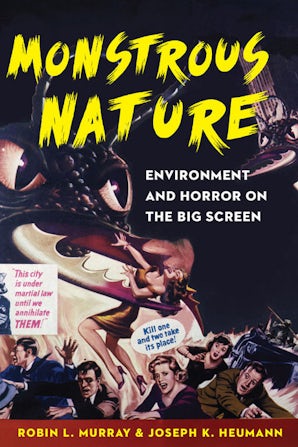
270 pages
22 illustrations, index
October 2016
978-0-8032-9492-9
$50.00 Add to CartOctober 2016
978-0-8032-9490-5
$50.00 Add to CartGodzilla, a traditional natural monster and representation of cinema’s subgenre of natural attack, also provides a cautionary symbol of the dangerous consequences of mistreating the natural world—monstrous nature on the attack. Horror films such as Godzilla invite an exploration of the complexities of a monstrous nature that humanity both creates and embodies.
Robin L. Murray and Joseph K. Heumann demonstrate how the horror film and its offshoots can often be understood in relation to a monstrous nature that has evolved either deliberately or by accident and that generates fear in humanity as both character and audience. This connection between fear and the natural world opens up possibilities for ecocritical readings often missing from research on monstrous nature, the environment, and the horror film.
Organized in relation to four recurring environmental themes in films that construct nature as a monster—anthropomorphism, human ecology, evolution, and gendered landscapes—the authors apply ecocritical perspectives to reveal the multiple ways nature is constructed as monstrous or in which the natural world itself constructs monsters. This interdisciplinary approach to film studies fuses cultural, theological, and scientific critiques to explore when and why nature becomes monstrous.
List of Illustrations
Acknowledgments
Introduction: Film, Environment, Horror
Part 1: Anthropomorphism and the “Big Bug” Movie
1. The Hellstrom Chronicle and Beetle Queen Conquers Tokyo: Anthropomorphizing Nature for Humans
2. “As Beautiful as a Butterfly”? Monstrous Cockroach Nature and the Horror Film
Part 2: Human Ecology and the Horror Film
3. The Earth Bites Back: Vampires and the Ecological Roots of Home
4. Through an Eco-lens of Childhood: Roberto Rossellini’s Germany Year Zero and Guillermo del Toro’s The Devil’s Backbone
Part 3: Evolution and Monstrous Nature
5. Zombie Evolution: A New World with or without Humans
6. Laughter and the Eco-horror Film: The Troma Solution
7. Parasite Evolution in the Eco-horror Film: When the Host Becomes the Monster
Part 4: Gendered Landscapes and Monstrous Bodies
8. Gendering the Cannibal: Bodies and Landscapes in Feminist Cannibal Movies
9. American Mary and Body Modification: Nature and the Art of Change
Conclusion: Monstrous Nature and the New Cli-Fi Cinema
Filmography
Notes
Works Cited
Index